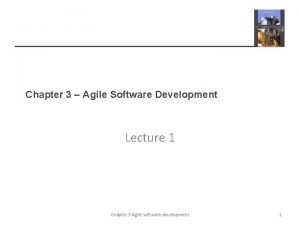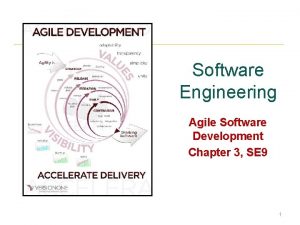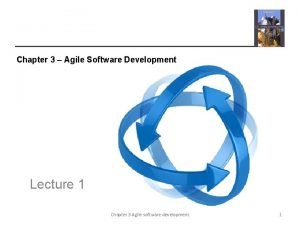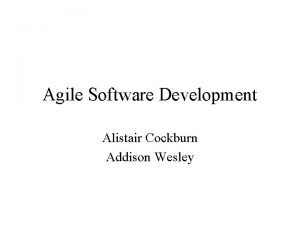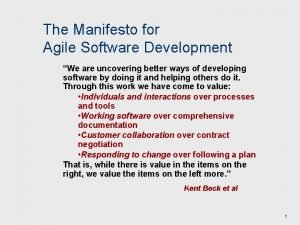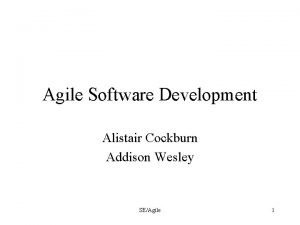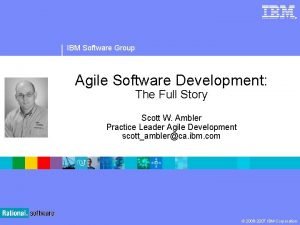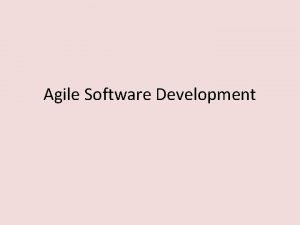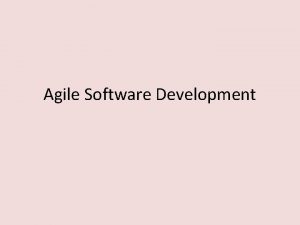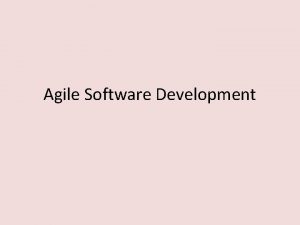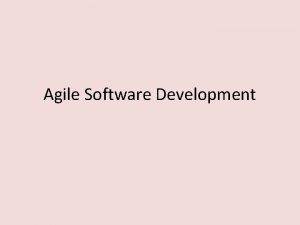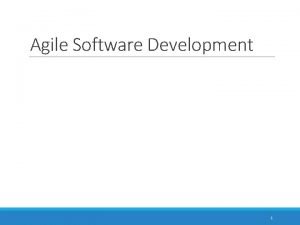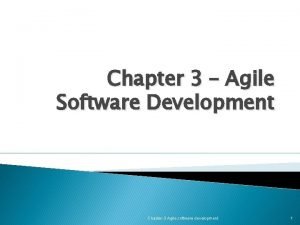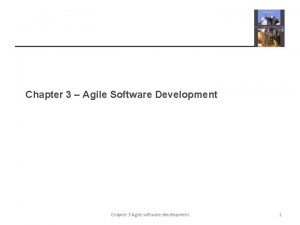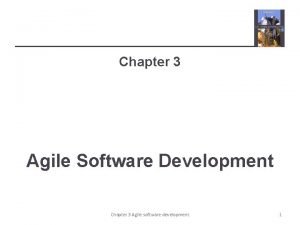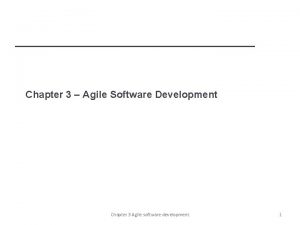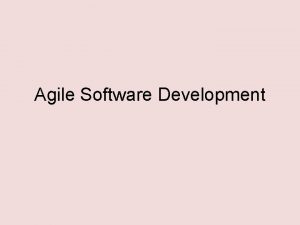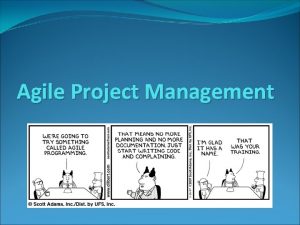Chapter 3 Agile software development 1 AGILE SOFTWARE














- Slides: 14

Chapter 3 Agile software development 1 AGILE SOFTWARE DEVELOPMENT LECTURE 06

RAPID SOFTWARE DEVELOPMENT ²Rapid development and delivery is now often the most important requirement for software systems § Businesses operate in a fast –changing environment and it is practically impossible to produce a set of stable software requirements § Software has to evolve quickly to reflect changing business needs ²Rapid software development Chapter 3 Agile software development 2 § Specification, design and implementation are inter-leaved § System is developed as a series of versions with stakeholders involved in version evaluation § User interfaces are often developed using an IDE and graphical toolset.

AGILE METHODS ²Dissatisfaction with the overheads involved in software design methods of the 1980 s and 1990 s led to the creation of agile methods. These methods: Chapter 3 Agile software development 3 § Focus on the code rather than the design § Are based on an iterative approach to software development § Are intended to deliver working software quickly and evolve this quickly to meet changing requirements. ²The aim of agile methods is to reduce overheads in the software process (e. g. by limiting documentation) and to be able to respond quickly to changing requirements without excessive rework.

AGILE MANIFESTO ²We are uncovering better ways of developing software by doing it and helping others do it. Through this work we have come to value: Chapter 3 Agile software development 4 § Individuals and interactions over processes and tools; Working software over comprehensive documentation; Customer collaboration over contract negotiation; Responding to change over following a plan; ²That is, while there is value in the items on the right, we value the items on the left more.

THE PRINCIPLES OF AGILE METHODS Principle Description Customer involvement Customers should be involved throughout the development process. Their role is provide and prioritize new system requirements and to evaluate the iterations of the system. People not process Embrace change Maintain simplicity Chapter 3 Agile software development The skills of the development team should be recognized and exploited. Team members should be left to develop their own ways of working without prescriptive processes. Expect the system requirements to change and so design the system to accommodate these changes. Focus on simplicity in both the software being developed and in the development process. Wherever possible, actively work to eliminate complexity from the system. 5 Incremental delivery The software is developed in increments with the customer specifying the requirements to be included in each increment.

AGILE METHOD APPLICABILITY ²Product development where a software company is developing a small or medium-sized product for sale. ²Custom system development within an organization, where there is a clear commitment from the customer to become involved in the development process and where there are not a lot of external rules and regulations that affect the software. Chapter 3 Agile software development 6 ²Because of their focus on small, tightly-integrated teams, there are problems in scaling agile methods to large systems.

PROBLEMS WITH AGILE METHODS ²It can be difficult to keep the interest of customers who are involved in the process. ²Team members may be unsuited to the intense involvement that characterises agile methods. ²Prioritising changes can be difficult where there are multiple stakeholders. ²Maintaining simplicity requires extra work. Chapter 3 Agile software development 7 ²Contracts may be a problem as with other approaches to iterative development.

AGILE METHODS AND SOFTWARE MAINTENANCE ²Most organizations spend more on maintaining existing software than they do on new software development. So, if agile methods are to be successful, they have to support maintenance as well as original development. ²Two key issues: Chapter 3 Agile software development 8 § Are systems that are developed using an agile approach maintainable, given the emphasis in the development process of minimizing formal documentation? § Can agile methods be used effectively for evolving a system in response to customer change requests? ²Problems may arise if original development team cannot be maintained.

SCRUM ²The Scrum approach is a general agile method but its focus is on managing iterative development rather than specific agile practices. ²There are three phases in Scrum. § The initial phase is an outline planning phase where you establish the general objectives for the project and design the software architecture. § This is followed by a series of sprint cycles, where each cycle develops an increment of the system. § The project closure phase wraps up the project, completes required documentation such as system help frames and user manuals and assesses the lessons learned from the project. Chapter 3 Agile software development 9 ²

Chapter 3 Agile software development 10 THE SCRUM PROCESS

THE SPRINT CYCLE ²Sprints are fixed length, normally 2– 4 weeks. ²The starting point for planning is the product backlog, which is the list of work to be done on the project. Chapter 3 Agile software development 11 ²The selection phase involves all of the project team who work with the customer to select the features and functionality to be developed during the sprint.

THE SPRINT CYCLE ²Once these are agreed, the team organize themselves to develop the software. During this stage the team is isolated from the customer and the organization, with all communications channelled through the so-called ‘Scrum master’. ²The role of the Scrum master is to protect the development team from external distractions. Chapter 3 Agile software development 12 ² At the end of the sprint, the work done is reviewed and presented to stakeholders. The next sprint cycle then begins.

TEAMWORK IN SCRUM ²The ‘Scrum master’ is a facilitator who arranges daily meetings, tracks the backlog of work to be done, records decisions, measures progress against the backlog and communicates with customers and management outside of the team. ²The whole team attends short daily meetings where all team members share information, describe their progress since the last meeting, problems that have arisen and what is planned for the following day. Chapter 3 Agile software development 13 § This means that everyone on the team knows what is going on and, if problems arise, can re-plan short-term work to cope with them.

SCRUM BENEFITS ²The product is broken down into a set of manageable and understandable chunks. ²Unstable requirements do not hold up progress. ²The whole team have visibility of everything and consequently team communication is improved. ²Customers see on-time delivery of increments and gain feedback on how the product works. Chapter 3 Agile software development 14 ²Trust between customers and developers is established and a positive culture is created in which everyone expects the project to succeed.
 Chapter 3 agile software development
Chapter 3 agile software development Chapter 3 agile software development
Chapter 3 agile software development Chapter 3 agile software development
Chapter 3 agile software development Msf for agile software development
Msf for agile software development Agile embedded software development
Agile embedded software development Alistair cockburn agile software development
Alistair cockburn agile software development Accounting for agile software development
Accounting for agile software development The manifesto for agile software development
The manifesto for agile software development Iso 9001 agile software development
Iso 9001 agile software development Agile software development alistair cockburn
Agile software development alistair cockburn Ibm agile development
Ibm agile development Dilbert agile
Dilbert agile Agile model driven development amdd
Agile model driven development amdd Agile game development
Agile game development Scrum for beginners
Scrum for beginners
